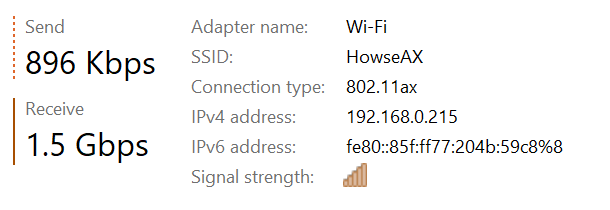AT 101: Wi-Fi 6 And Why You Want It
by Brett Howse on February 12, 2020 8:00 AM ESTTo The Future
If the question is do you need Wi-Fi 6, the answer is most assuredly “maybe”. The performance improvements are substantial, but really rely on a very strong signal to get the most data throughput. Most of the new features of Wi-Fi 6 focus on the influx of devices to the standard, and dealing with many devices connected to the same access point, or devices trying to share spectrum when connected to different access points.
The addition of Orthogonal Frequency Division Multiple Access to the Wi-Fi 6 standard will likely be the most impactful change to this revision. It will allow access points to carve up their channels into smaller slices, allowing more devices to communicate at the same time with less overhead. Each device will lose out on peak throughput, but the reduced latency should help a lot, especially in very dense environments. It should help with excessive overhead on the network layer when multiple devices are sending many small packets at once, which is a very common scenario, especially in an office or stadium situation.
Multi-User MIMO was in the Wi-Fi 5 specification as an optional implementation, and as such it did not really take off. Wi-Fi 6 should make this more prevalent, and also adds support to the MU-MIMO on the uplink, not just the downlink side. This will increase the capacity of access points for higher-speed use cases, but MU-MIMO did not get a lot of traction in Wi-Fi 5 so we will have to see how much adoption it gets in Wi-Fi 6.
The wider 160 MHz channels will offer significantly more throughput in the home environment, as we saw in our performance tests. As with the 1024-level QAM though, to see the biggest benefit you will need a strong signal. The vast majority of home networking is still limited to 1 Gigabit Ethernet, which puts Wi-Fi 6 into somewhat of an awkward spot, since it can transfer faster than most wired home networks, but even so, that is still a significant improvement over Wi-Fi 5 which would cap out around 600 Mbps on the best Wi-Fi adapters. If you work with a lot of large files, and you prefer to use Wi-Fi instead of the more consistent, yet cumbersome Ethernet, there’s still a nice boost to be had.
The future looks strong for Wi-Fi, and the Wi-Fi Alliance has made some excellent revisions to their standard to help improve Wi-Fi for the next generation of devices. As with any standards change, the impacts will not be seen right away. Both the access point, and the client need to be leveraging the new standard for the improvements to be noticeable. We’ve already seen the latest generation of smartphones start to offer Wi-Fi 6, and there’s been some movement in the PC space as well with Intel’s Project Athena. Anyone looking at a new router today should certainly opt for a Wi-Fi 6 model, but there’s likely not a major need for most people to move from Wi-Fi 5 access points right away. If you live in a heavily congested wireless area, the advantages of features like BSS coloring and Spatial Frequency Reuse should help out in those scenarios, but for people looking at purely performance, Wi-Fi 6 somewhat runs into a wall of its own making, since it can now transfer at over Gigabit speeds on a typical 2x2:2 connection. But who are we to question performance?












149 Comments
View All Comments
evilspoons - Wednesday, February 12, 2020 - link
Ubiquiti devices work as normal routers. You take your normal internet connection, wired ethernet coming out of your modem, and plug it into the WAN port of the Ubiquiti router.nathanddrews - Friday, February 14, 2020 - link
I run a custom pfSense router/firewall/gateway, so it would run as an AP only. It's incredible how terrible most consumer/prosumer routers are compared to a pfSense install on basic hardware.Xyler94 - Wednesday, February 12, 2020 - link
Most if not all?Most home routers don't have the interfaces to link directly into the feed, nor the proper security creds to get connections, but more often than not, their modem can be configured in Bridge Mode, which then the modem acts as the bridge between your network and the ISP network. The modem turns off all routing and NAT features, and basically hopes the router next to it does that work. I recently configured mine in Bridge Mode because I now have a Fortinet Firewall.
gobaers - Wednesday, February 12, 2020 - link
Yep, this. I refuse to allow the ISP to have a device on my internal network, they are and should remain dumb pipes.Makaveli - Wednesday, February 12, 2020 - link
I do this on Fiber.ISP provider modem/router is in the closet.
Router Asus AX88U using a Media converter.
Bell Canada uses GPON
So Fiber going directly into media converter then Ethernet from converter to Asus router and its runs great.
Dug - Wednesday, February 12, 2020 - link
OFDMA isn't necessarily broken, it's a compatibility issue though. This is from Tim on smbforums."But the larger problem appears to be compatibility problems with older legacy devices that have not had driver updates. Some devices don't understand the new information in beacon frames, so they either don't associate at all or don't stay associated.
There are more problems with 2.4 GHz devices than 5 GHz, but both bands have problems. Routers makers are very reluctant to enable OFDMA and break their customers' Wi-Fi."
So it looks as though OFDMA could work, but by doing so it may reduce the devices that can connect if you have older devices. I've seen this commented before from others that have done testing.
DanNeely - Wednesday, February 12, 2020 - link
If the issue is drivers for legacy devices, I suspect the only work around on time scales shorter than the next decade (or longer if some OEMs can save a penny/unit by using a crappy chipset that doesn't support it) will be to run 2 parallel 5/6 ghz wireless connections (one with and one without) similar to how we currently run both 2.4 and 5ghz service; one for the legacy devices that will never be updated and one for modern hardware.Whiteknight2020 - Wednesday, February 12, 2020 - link
Well, according to that link there are some that do, Asus ax88 for one (on 5ghz).Makaveli - Wednesday, February 12, 2020 - link
What is your definition of True OFDMA.The article you posted which I've already read since i'm a member of the SNB forum.
Shows its enabled on the AX88U but only on the 5Ghz. Which would be fine for me as I don't use 2.4ghz for anything.
Ryan Smith - Wednesday, February 12, 2020 - link
Funny enough, Asus just finally turned on OFDMA support in the GT-AX11000 in the latest firmware, which was released last month. So that landed just as we got the hardware.